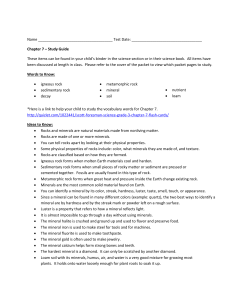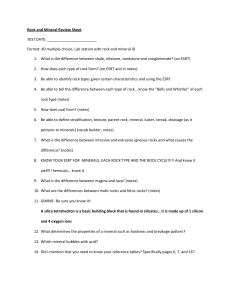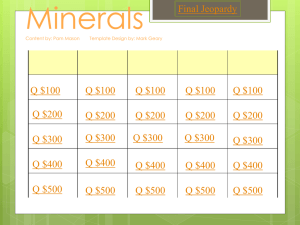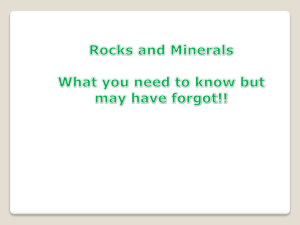Excerpt - South Pointe Elementary School
advertisement
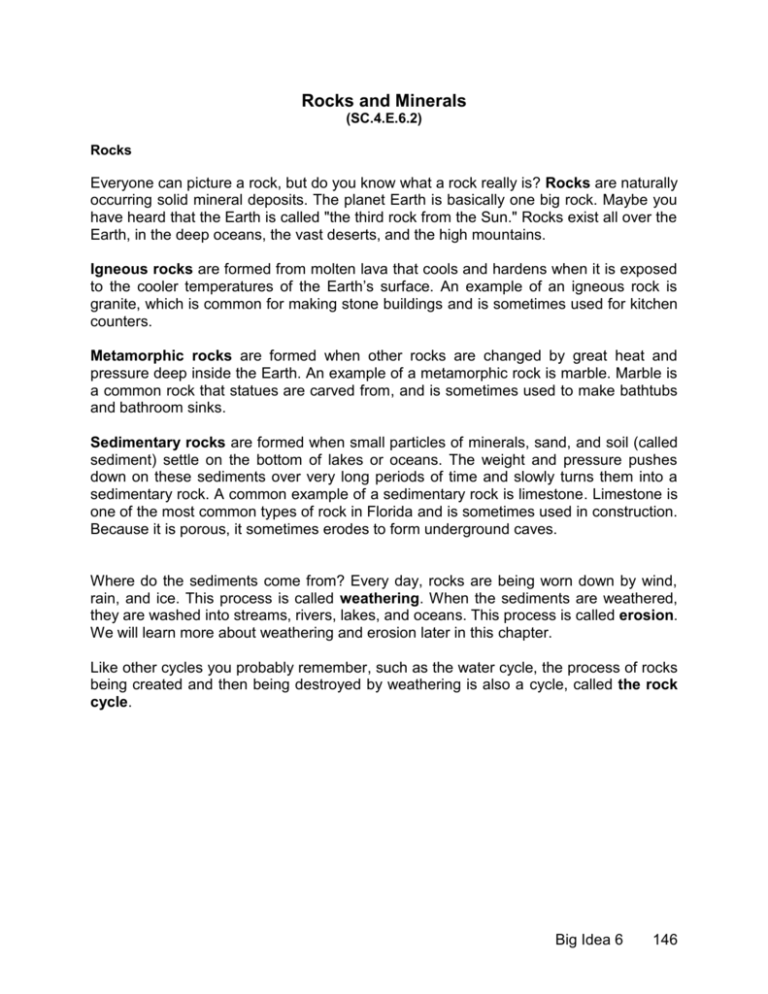
Rocks and Minerals (SC.4.E.6.2) Rocks Everyone can picture a rock, but do you know what a rock really is? Rocks are naturally occurring solid mineral deposits. The planet Earth is basically one big rock. Maybe you have heard that the Earth is called "the third rock from the Sun." Rocks exist all over the Earth, in the deep oceans, the vast deserts, and the high mountains. Igneous rocks are formed from molten lava that cools and hardens when it is exposed to the cooler temperatures of the Earth’s surface. An example of an igneous rock is granite, which is common for making stone buildings and is sometimes used for kitchen counters. Metamorphic rocks are formed when other rocks are changed by great heat and pressure deep inside the Earth. An example of a metamorphic rock is marble. Marble is a common rock that statues are carved from, and is sometimes used to make bathtubs and bathroom sinks. Sedimentary rocks are formed when small particles of minerals, sand, and soil (called sediment) settle on the bottom of lakes or oceans. The weight and pressure pushes down on these sediments over very long periods of time and slowly turns them into a sedimentary rock. A common example of a sedimentary rock is limestone. Limestone is one of the most common types of rock in Florida and is sometimes used in construction. Because it is porous, it sometimes erodes to form underground caves. Where do the sediments come from? Every day, rocks are being worn down by wind, rain, and ice. This process is called weathering. When the sediments are weathered, they are washed into streams, rivers, lakes, and oceans. This process is called erosion. We will learn more about weathering and erosion later in this chapter. Like other cycles you probably remember, such as the water cycle, the process of rocks being created and then being destroyed by weathering is also a cycle, called the rock cycle. Big Idea 6 146 Big Idea 6 147 Minerals Earlier we said that rocks are naturally occurring solid mineral deposits, but what does that mean? Minerals are the building blocks of rocks. A rock is usually made up of two or more minerals. Every mineral is made of one or more elements and has a crystal structure. Minerals are always solid and can be found in nature. Scientists have identified over 4,000 minerals. There are several properties scientists use to classify different minerals. Some of these properties are listed in the table below. Properties Used to Classify Minerals Property Hardness Description Moh’s scale determines how hard a mineral is using the numbers 1-10. The lower the number, the softer the mineral. The higher the number, the harder the mineral. Diamonds have a hardness of 10 and are the hardest mineral. Color Color is a good way to describe a mineral as a first step toward identifying it. Some minerals vary in color, so this category is often combined with luster or steak color to make a more accurate classification. Luster Luster tells you how light reflects off of a mineral's surface. A mineral can have a metallic, glassy, pearly, dull, or earthy luster. Cleavage Streak Color Graphic The way a mineral breaks determines its cleavage. If it breaks along a smooth, flat surface, the mineral has cleavage. If it is jagged when broken, it has fracture. To find the streak color of a mineral, scientists take the mineral and rub it on a rough, hard surface called a streak plate that causes the mineral to form a powder. The color of the powder is the mineral's streak color. Big Idea 6 148 Properties of Some Common Minerals Mineral Hardness Color Quartz 7 - hard varies 6somewhat hard Mica Luster Cleavage Streak Color glassy none white light pink, gray, green or white glassy uneven or smooth and shell-like white 3 - soft reddish, green or white pearly or metallic thin, flexible sheets white Calcite 3 - soft varies glassy six-sided crystals white Talc 1 - very soft white, green, brown or gray waxy or greasy thin, flat sheets white Pyrite 6somewhat hard yellow metallic smooth, shell-like greenish black Graphite 1.5 - very soft black metallic or dull thin, flexible flakes black 10 - very hard blue, yellow, colorless, waxy or perfect, red, orange, nonmetallic octahedrons green, brown Feldspar Diamond white or none/ diamond is harder than the streak plate 6. There are three types of rocks – igneous, sedimentary and metamorphic. Describe how each type of rock is formed. ___________________________________________________________________ ___________________________________________________________________ ___________________________________________________________________ ___________________________________________________________________ ___________________________________________________________________ Big Idea 6 149 7. The table below shows whether or not each mineral can scratch the other minerals. Based on the table, which mineral is the hardest? a. Mineral A b. Mineral B c. Mineral C 8. Daunte performed several tests on a mineral to help identify it. The picture below shows one of the tests he performed. Which property of a mineral will he be able to identify using this test? a. b. c. d. Attraction to magnets Streak color Hardness Cleavage Big Idea 6 150 9. The picture below shows how a type of rock forms at the bottom of the ocean. What type of rock is this? a. b. c. d. Lava Igneous Sedimentary Metamorphic Big Idea 6 151


